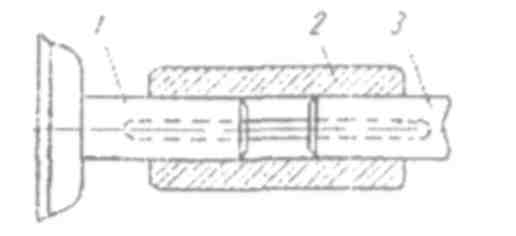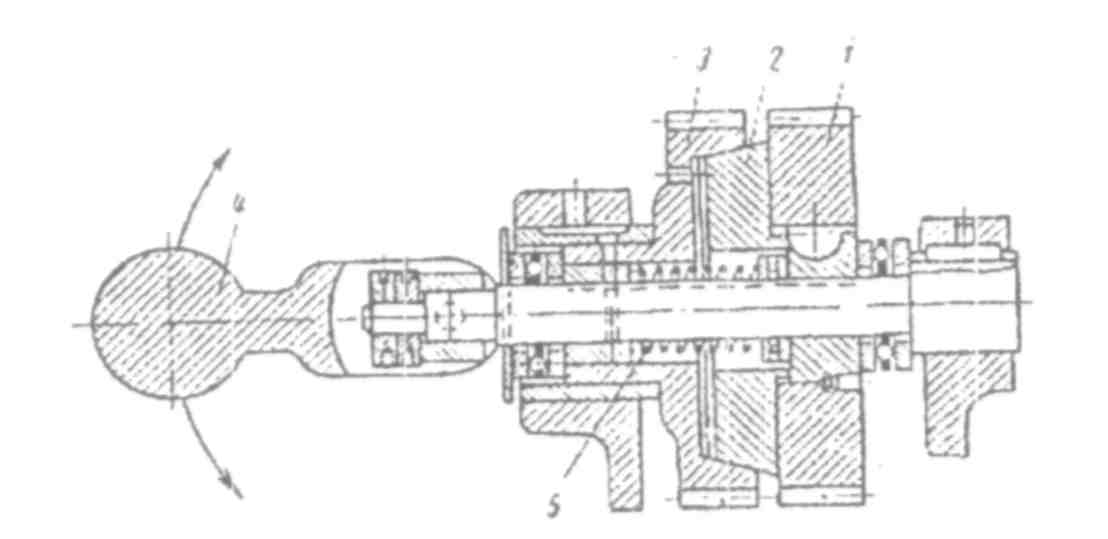
- •2. Steel
- •4. Properties of engineering materials and methods of testing them
- •1. Chipping metal and chipping tools
- •2. Metal-cutting and locksmith's cutting tools
- •3. Filing and filing tools
- •4. Mechanical tools
- •5. Measuring tools and devices
- •1, 2, 3, 8 -Jaws; 4 - adjusting screw; 5 - primary scale; 6 - depth rod;
- •6. Machine-cutting tools
- •7. Drills and drilling
- •8. Threading tools
- •9. Methods of holding tools between centres
- •10. Holding work in a chuck
- •II. Holding work in a vice
- •Chapter III machine parts
- •1. Welding
- •2. Induction brazing and soldering
- •3. Threads
- •4. Gears
- •5. Belt and chain drives
- •6. Bearings
- •7. Clutches
- •Chapter IV metal-cutting machines
- •1. Lathes
- •2. Drilling machines
- •3. Milling machines
- •4. Planers
- •5. Shapers and slotters
- •6. Grinding and grinding machines
- •Chapter V texts for home reading
- •1. The russian metallurgist d. K. Chernov
- •2. Oxygen in the bessemer converter
- •3. Oxygen enrichment in the blast furnace
- •4. Oxygen for direct reduction of iron ore
- •5. Crucible furnace
- •6. Portable hardness tester
- •7. High-speed precision ball bearing testing machines
- •Составные предлоги
- •Сокращения
- •Англо-русский словарь
7. Clutches
A clutch is a device for connecting two parts, such as shafts or a shaft and a pulley. The difference between a coupling and a clutch is that a coupling is used to connect two shafts permanently, while a clutch may ensure easy and quick connection and disconnection of two shafts. Clutches used in lathes are subdivided into several types, such as rigid couplings and disengaging clutches. A. rigid coupling serves for connecting coaxial shafts which are not disengaged in the. process of operation. Fig. 45 shows a rigid coupling, which consists of a solid bushing connecting electric motor and lathe shafts by means of a key. Disengaging clutches are applied in lathes for temporary engagement and disengagement of a shaft and parts connected with it. They are divided into friction clutches and yaw clutches. Friction clutches serve to connect а stationary machine part to transmit the required power. Sometimes friction clutches are intended as safety devices to prevent the breakage of parts in the transmission train.

Fig.45. Rigid Coupling:
1- electric motor shaft; 2- solid bushing; 3- lathe shaft

Fig. 46. Cone Clutch:
1 - toothed wheel; 2 - cone disc; 3 - movable wheel; 4 -eccentric clamp; 5 – spring
Friction clutches may be divided into two groups, according to the direction of the acting force: axial clutches and radial or rim clutches. In axial clutches the contact pressure is applied in a direction parallel to the axis of rotation, while in rim clutches the contact pressure is applied upon a rim in a radial direction. Axial clutches can be subdivided into cone clutches, and combined cone and disc clutches. Fig. 46 shows a cone clutch. By moving a movable wheel the cone disc connected with the toothed wheel by a key may engage the cone located in the movable wheel. Thus the cone disc is pressed against the inside cone of the movable disc, friction necessary for transmitting rotary movement to the movable wheel being created between the two cones. The outside cones are meshed by an eccentric clamp. By turning the eccentric clamp to 90° the friction clutch is disengaged, a spring pressing out the toothed wheel from the friction disc. Radial or rim clutches may be classified as band clutches, block clutches, and as external, internal, and combined internal and external clutches. Jaw clutches consist of two half-clutches – a. fixed one and a movable one which have jaws on their faces. The fixed half-clutch is rigidly fastened on one shaft, the movable one being keyed to another shaft. The shafts are connected through the coupling of jaws on both half-clutches.
The following factors are decisive in selecting the type of clutch to be used: torque, rotative speed, available space, and frequency of operation. When a heavy torque should be transmitted a clutch must have sufficient gripping power, which is usually ensured by multi-disc clutches. For low-speed service cone and rim clutches are used. For high rotative speeds light, compact and internally balanced clutches of the multi-disc type may be applied. Space being limited, multi-disc, twin-cone and double-cone clutches are used because of their greater compactness in comparison with other types of clutches. Single-disc clutches with metal contact surfaces and cone clutches are the most suitable ones for frequent or continuous operation.
Exercises
I. Use the following words and phrases in sentences of your own:
clutch, coupling, rigid coupling, disengaging clutch, coaxial, key, friction clutch, transmission train, axial clutch, rim clutch, jaw clutch, to engage, fixed clutch, eccentric clamp, suitable
II. Retell the text giving answers to the following questions:
1. What is the difference between a clutch and a coupling? 2. How are clutches subdivided? 3. What does a rigid coupling serve for? 4. What is a disengaging clutch applied for? 5. What is a friction clutch? 6. How are friction clutches classified? 7. What is the difference in application of the contact pressure in axial clutches and in radial clutches?
III. Choose synonymical groups out of the following list:
rigid, to connect, frequently, different, to engage, tendency, to join, various, hard, to gear, often, direction, rotation, transmission, revolution, transferring
IV. Choose antonymical groups out of the following list:
to divide, movable, to engage, external, to connect, immovable, to disconnect, to unlink, to stop, internal, to start, to combine
V. Underline the suffixes and prefixes and translate into Russian the following words:
engage, engagement, engaging, disengaging, disengagement; determination, predetermination; station, stationary; intensity, intensive; rigidly, rigidity
VI. Connect the following sentences using the absolute participle construction and translate them into Russian:
Example: A rigid coupling connects coaxial shafts.
Coaxial shafts are not disengaged in the process of operation.
A rigid coupling connecting coaxial shafts, they are not disengaged in the process of operation.
1. The construction of some new clutches has already been completed. We ordered some of them. 2. Numerous experiments have been carried out. The design of the new jaw clutches was approved. 3. The clutches used in lathes are subdivided into several types. The friction clutches are subdivided into two groups. 4. A spring presses out the wheel from the disc. By turning the eccentric clamp, the cone clutch is disengaged. 5. Clutch constructions are based on the positive-action and friction principles. Couplings are made in two main types: rigid and flexible.
VII. Translate the following sentences into English using the absolute participle construction:
Example: Когда расстояние между валами ограничено, используются многодисковые муфты.
The distance between shafts being limited, multi-disc clutches are used.
1. Так как некоторые валы имеют небольшое отклонение от соосности, применяется упругое соединение. 2. Схематическое устройство конусной фрикционной муфты показано на рис. 46; конический диск может при
перемещении подвижного колеса входить во внутренний конус. 3. Когда кулачковая муфта включена влево, вращение от ведущего вала передается ведомому валу через колеса. 4. Если кулачковую муфту включить вправо, то вращение передается ведомому валу через зубчатые колеса. 5. Так как кулачки легко повреждаются, кулачковые муфты переключаются только при остановленном станке.
VIII. Translate the following sentences into Russian observing different meanings of the word "part":
1. The part of the work was completed in time. 2. The second part of London's complete works has been published. 3. This part of the machine was worn due to bad lubrication. 4. They part when he goes to sea. 5. They took part in a discussion on the manufacture of new clutches.
IX. Translate the following text in written form using a dictionary:
The multi-disc clutch is usually equipped with automatic cone brake. Moving the clutch control handle to the left compresses the clutch driving discs to set the lathe driving shaft in motion. To disengage the clutch, the clutch control handle should be moved to the right. The clutch driving discs then automatically separate and the brake takes hold to stop the lathe driving shaft with a smooth, quick stop, holding it rigid for ease in locking work in chuck or other operations requiring a fixed spindle. When necessary to turn the spindle by hand, it may be entirely disconnected from the driving shaft by throwing the lathe's regular gearshift handles into their neutral position1. The speed with which the brake will stop the lathe is affected by weight of the workpiece that is in the lathe.
1. throwing... into neutral position - переключением... их в нейтральное положение
X. Using the following words and word combinations describe the clutches in Figs 45 and 46:
a rigid coupling, to be represented, Fig. 46, to consist, a solid bushing, to connect, electric motor, lathe shafts, a key, axial clutches, to be subdivided, cone clutches, disc clutches, to be shown, the cone disc of the cone clutch, to be connected, the toothed wheel, to engage the cone, to be located, the movable wheel, friction necessary, to transmit rotary motion, to be created, the two cones, to be meshed, an eccentric clamp, the friction clutch, to be disengaged, the eccentric clamp, to be turned to 90°, a spring, to press out, friction disc
